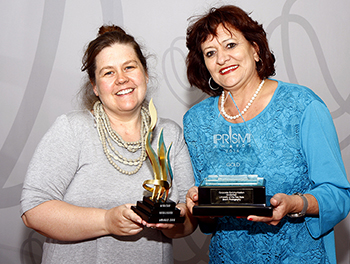UFS Communication and Brand Management Department once again honoured for ground-breaking communication work

The UFS was announced as winner in the internal communication category of the African Excellence Award after entering the B Safe Take Action campaign. The university also received a Gold Award at the 2016 PRISM Awards. Here are Martie Nortjé, Assistant Director: Communication and Brand Management, and Leonie Bolleurs, Assistant Director: Internal Communication, from the University of the Free State.
Photo: Hannes Pieterse |
Within a week, the Department of Communication and Brand Management at the University of the Free State brought home two gold awards. In April this year, the department was announced as winner in the Internal Communication Category of the African Excellence Awards for the B Safe Take Action campaign. They also received Gold at the 2016 PRISM Awards for the KovsieGear entry.
PRISM Award for the UFS KovsieGear shop
Martie Nortjé, Assistant Director: Branding and Merchandise, attended the PRISM Award function in Johannesburg where she received the Gold award for the UFS KovsieGear shop for the best entry in the corporate communication category. This is the second consecutive year that the department received Gold at the PRISM Awards. Last year, the department received Gold for the B Safe Take Action campaign.
The idea for a university-owned shop was initiated in 2013. Launched in January 2014, KovsieGear is used to strengthen the brand and creating a sense of ownership among all stakeholders. The KovsieGear team is grateful for the continuous support of staff and students, as well as alumni.
The PRISM awards of the Public Relations Institute of Southern Africa (PRISA) are Africa’s most sought-after award in the public relations industry, and are presented to public relations and communication professionals who have incorporated strategy, creativity, and professionalism successfully into public relations and communication programmes and strategies, showcasing a successful public relations campaign.
African Excellence Award for B Safe Take Action Campaign
The B Safe Take Action campaign also received an award recently at a gala event hosted by the African Excellence Awards in Cape Town. Leonie Bolleurs, Project Manager of the B Safe Take Action campaign, received the award on behalf of the university.
It is of cardinal importance for the university that its students, staff, and assets are safe. Once again, this award demonstrates that the university is serious about the safety of its staff and students. This is especially so, since it is the objective of the campaign to develop a culture of safety awareness in students and staff alike.
The hosts of the African Excellence Awards are The Communication Director, the magazine for Corporate Communications and Public Relations (PR) in Europe, which enjoys worldwide distribution. According to Rudolf Hetzel, Chairman of the jury and publisher of The Communication Director, the African Excellence Awards are an opportunity for all those working in the field of PR and communications throughout Africa to come together, and honour ground-breaking communication campaigns and projects.
Quality work
“I am extremely proud of the Communication and Brand Management team for performing excellently once again in national and continental awards programmes. The awards are a good benchmark for the quality and standard of the work we produce,” said Lacea Loader, Director of the Department of Communication and Brand Management.
In the past two years, the department also received other awards for their work. This include:
- UFS #FaceOfFacebook campaign received a Gold Quill Excellence Award from the International Association for Business Communicators (IABC), both internationally and in the Africa region.
- B Safe Take Action campaign received a Gold Quill Merit Award from the IABC, both internationally and in the Africa region.
- UFS #FaceOfFacebook campaign received a Bronze Stevie Award from the International Business Awards (IBA).
- B Safe Take Action campaign received a Bronze Stevie Award from the IBA.
- #UFStoday Facebook campaign received a Merit Award from Marketing Advancement Communication in Education (MACE).
- The NSFAS awareness campaign received a Merit Award from MACE.